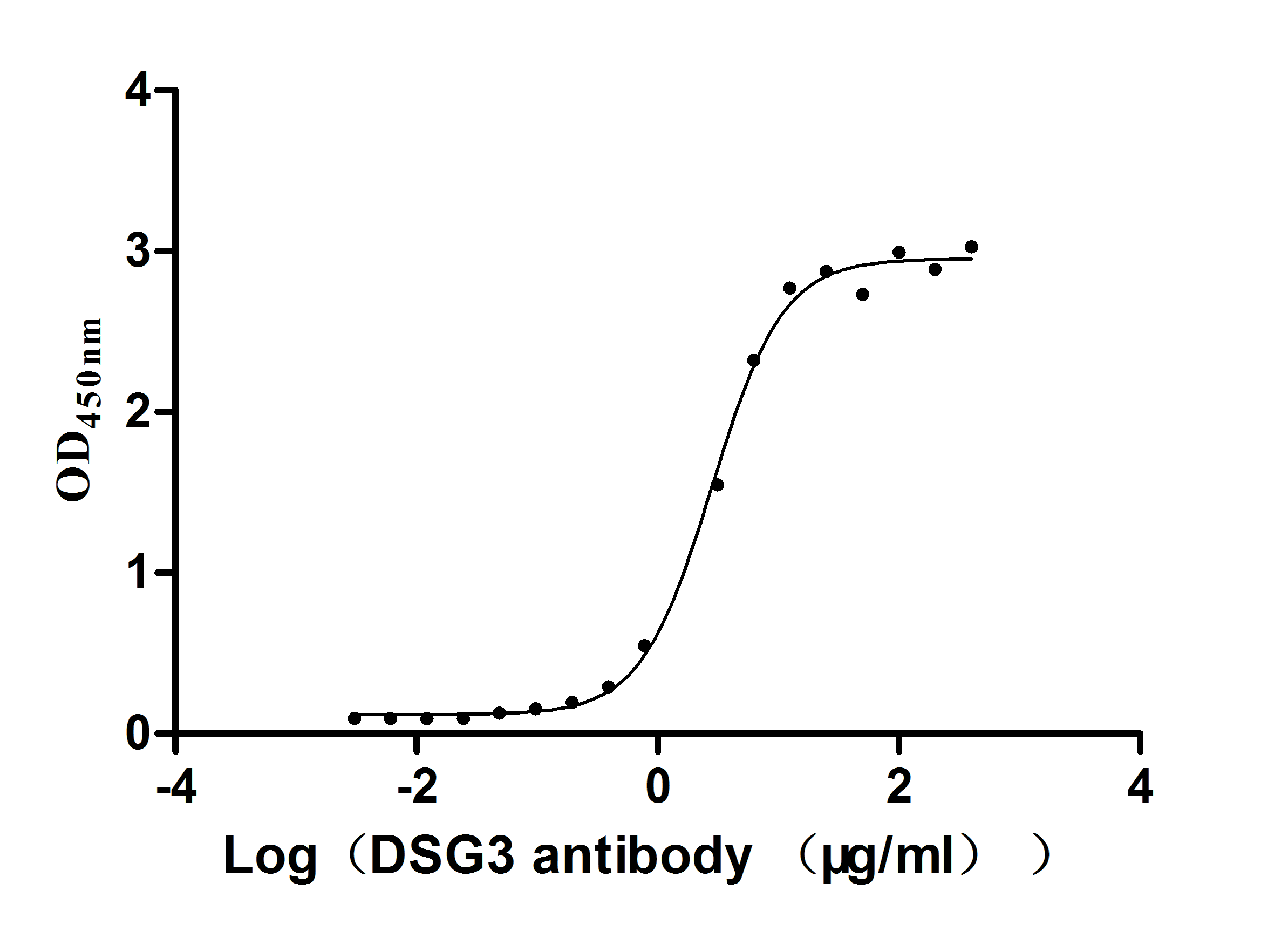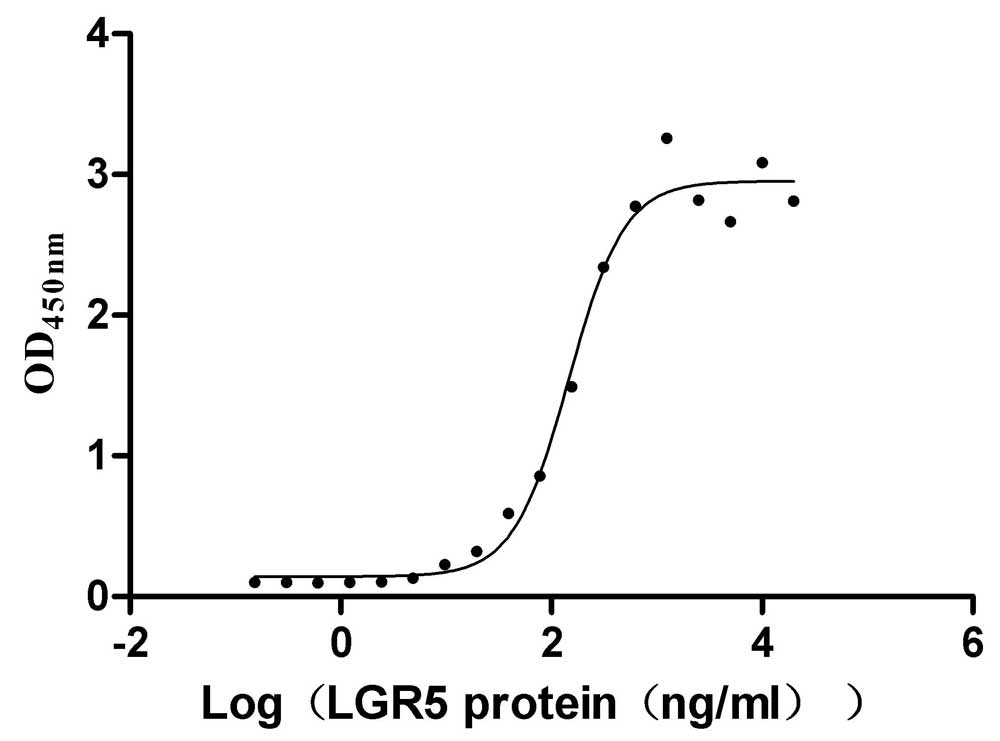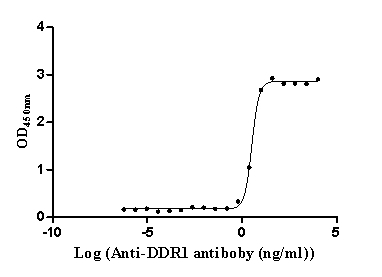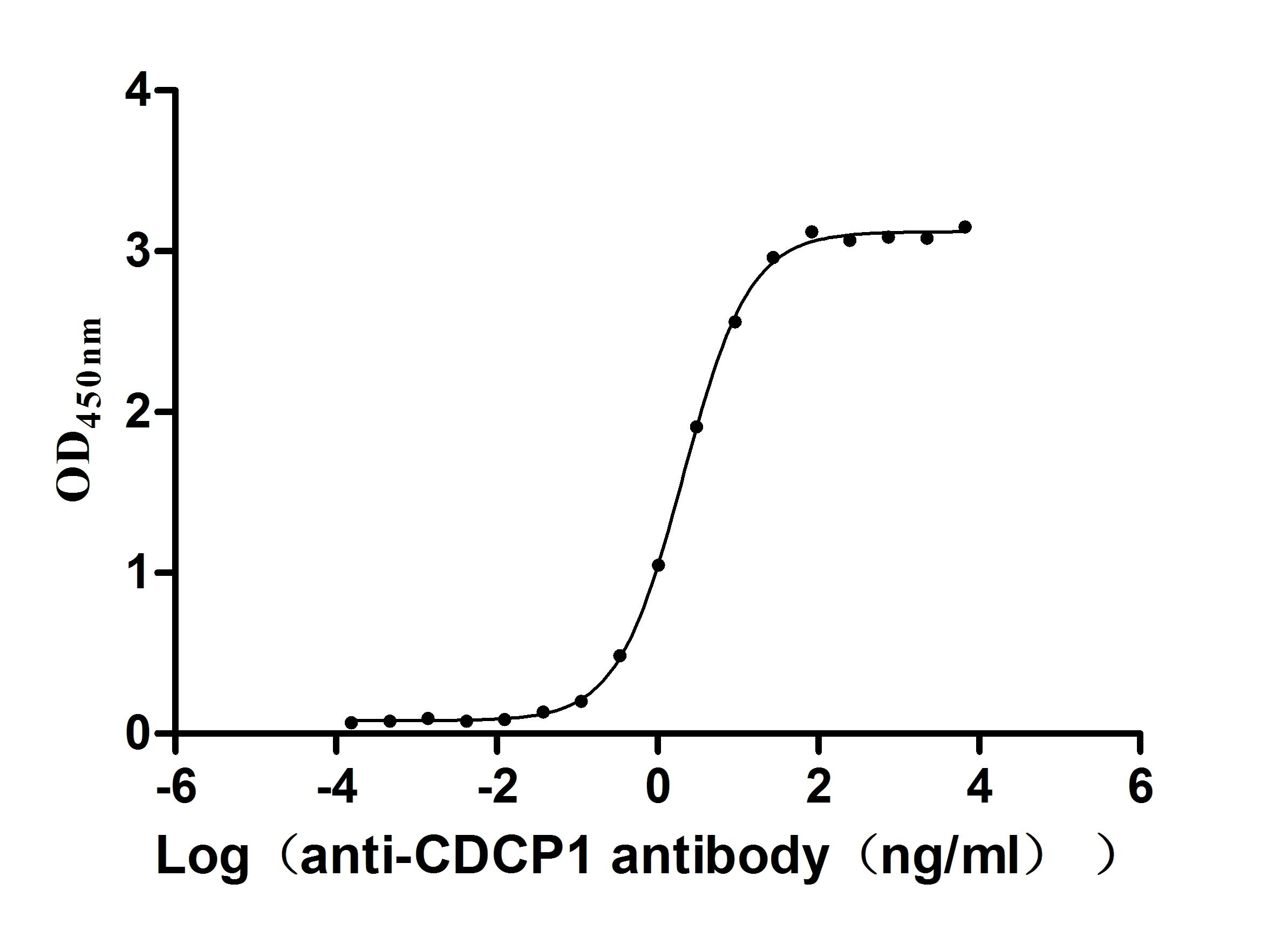Recombinant Human Type-1 angiotensin II receptor (AGTR1), partial
-
货号:CSB-YP001465HU
-
规格:¥2208
-
图片:
-
其他:
产品详情
-
纯度:Greater than 90% as determined by SDS-PAGE.
-
基因名:
-
Uniprot No.:
-
别名:AG2S; Agtr 1; Agtr1; AGTR1_HUMAN; Agtr1a; AGTR1B; Ang II; Angiotensin II receptor type 1; Angiotensin II type-1 receptor; Angiotensin receptor 1; Angiotensin receptor 1B; AT 1B; AT 1r; AT1; At1a; AT1AR; AT1B; AT1BR; AT1R; AT2R1; AT2R1A; AT2R1B; HAT1R; Type 1 angiotensin II receptor; Type 1B angiotensin II receptor; Type-1 angiotensin II receptor
-
种属:Homo sapiens (Human)
-
蛋白长度:Partial
-
来源:Yeast
-
分子量:9.2kDa
-
表达区域:297-359aa
-
氨基酸序列LNPLFYGFLGKKFKRYFLQLLKYIPPKAKSHSNLSTKMSTLSYRPSDNVSSSTKKPAPCFEVE
Note: The complete sequence including tag sequence, target protein sequence and linker sequence could be provided upon request. -
蛋白标签:N-terminal 6xHis-tagged
-
产品提供形式:Liquid or Lyophilized powder
Note: We will preferentially ship the format that we have in stock, however, if you have any special requirement for the format, please remark your requirement when placing the order, we will prepare according to your demand. -
缓冲液:Tris-based buffer,50% glycerol
-
储存条件:Store at -20°C/-80°C upon receipt, aliquoting is necessary for mutiple use. Avoid repeated freeze-thaw cycles.
-
保质期:The shelf life is related to many factors, storage state, buffer ingredients, storage temperature and the stability of the protein itself.
Generally, the shelf life of liquid form is 6 months at -20°C/-80°C. The shelf life of lyophilized form is 12 months at -20°C/-80°C. -
货期:Basically, we can dispatch the products out in 1-3 working days after receiving your orders. Delivery time may differ from different purchasing way or location, please kindly consult your local distributors for specific delivery time.Note: All of our proteins are default shipped with normal blue ice packs, if you request to ship with dry ice, please communicate with us in advance and extra fees will be charged.
-
注意事项:Repeated freezing and thawing is not recommended. Store working aliquots at 4°C for up to one week.
-
产品描述:
The preparation of Recombinant Human AGTR1 protein included 3 main steps: construct the expression vector, expression of protein of interest, and protein purification. Every step was performed under a strict QC system so that we got the premium protein. This AGTR1 was expressed in Yeast at and fused with N-terminal 6xHis tag. According to SDS-PAGE, the purity turns out to be 90%+.
AGTR1 encodes the angiotensin II (Ang II) type I receptor that belongs to the family of G-protein coupled receptors. AGTR1 is an important part of the Renin-angiotensin system (RAS). AGTR1 has a strong influence on tumor growth, angiogenesis, inflammation, and immunity. Hypomethylation in the AGTR1 promoter had been validated to be inversely correlated with uric acid levels, which can be a significant risk predictor of essential hypertension (EH). Besides, AGTR1 methylation had been extensively studied in human cancers, such as oral squamous cell carcinoma. For example, a study showed that AGTR1 mediates breast cancer metastasis by regulating CXCR4/SDF-1α. Another study showed that AGTR1 promotes the invasion of breast cancer. Based on the pan-cancer analysis, researchers found that the expression of AGTR1 in most tumor tissues, including lung cancer, was significantly lower than the corresponding normal tissues and was related to prognosis.
-
Datasheet & COA:Please contact us to get it.
相关产品
靶点详情
-
功能:Receptor for angiotensin II. Mediates its action by association with G proteins that activate a phosphatidylinositol-calcium second messenger system.; (Microbial infection) During SARS coronavirus-2/SARS-CoV-2 infection, it is able to recognize and internalize the complex formed by secreted ACE2 and SARS-CoV-2 spike protein through DNM2/dynamin 2-dependent endocytosis.
-
基因功能参考文献:
- Intracrine action of angiotensin II in mesangial cells: subcellular distribution of angiotensin II receptor subtypes AT1 and AT2. PMID: 29455433
- Meta-analysis suggests that AGTR1 A1166C polymorphism may increase the susceptibility to diabetic nephropathy. PMID: 30313019
- Results may indicate that the choice of diet can undermine the potential genetic risk of the AT1R 1166A>C polymorphism for MetS, and persons who are variant carriers may spontaneously choose the Mediterranean diet. PMID: 30205174
- The research reveals that among patients with essential hypertension treated with hypotensive drugs there are certain relationships between the rs5182 and rs5186 polymorphisms of the AGTR1 gene, as well as between the rs1799998 polymorphism of the CYP11B2 gene and the volume of the carotid bodies. PMID: 29627490
- The protective effects of short-term hypoxia (STH) are associated with the upregulation of MasR to inhibit AT1 R signaling. STH could be a potential therapeutic strategy for cardiac diseases in hypertensive patients. PMID: 29052864
- A high level of ART1 antibodies was a risk factor for allograft function in kidney transplant recipients. PMID: 29507275
- we found an interaction between ACE2 and AGTR1 in structuralatrial fibrillation patients in a Chinese Han population PMID: 29441892
- AGTR1 DNA hypomethylation is a risk factor for the development of hypertension. Furthermore, there is a correlation between smoking, diet, and AGTR1 DNA methylation levels. PMID: 28376480
- Chinese Han persons with C allele of rs9817428 in PPARG gene were related to the increased risk of hypertension. PMID: 29266977
- Association of AGTR1 single nucleotide polymorphism rs275645 and pre-eclampsia in Chinese population. PMID: 27910864
- although the present study did not find any association between AGTR1 A1166C polymorphism and the risk of systemic lupus erythematosus, the presence of this polymorphism was associated with higher levels of malondialdehyde and higher concentration of neopterin PMID: 28530466
- We conclude that the crosstalk between angiotensin AT1 receptor and insulin receptor signaling shows a high degree of specificity, and involves Galphaq protein, and activation of distinct kinases. Thus, the BRET(2) technique can be used as a platform for studying molecular mechanisms of crosstalk between insulin receptor and 7TM receptors. PMID: 28854843
- The AGTR1-mediated cell apoptosis was suppressed by overexpressing miR-1248 and inhibited protein translation of AGTR1 by miR-1248, through binding to the 3'-UTR of the AGTR1 mRNA. PMID: 29482191
- The effects ofgenetic polymorphisms and diet on the risk of metabolic disorders predisposing to cardiovascular diseases among Malay, Chinese, and South Asian persons are reported. PMID: 28792482
- AGTR1 gene, related to renin-angiotensin system, might play momentous roles in the initiation and development of consecutive Trauma-Induced Sepsis. PMID: 29642183
- The genotypes of REN, AT1R and AT2R were not associated with the development of preeclampsia in South African Black women. PMID: 28641212
- AC-CC genotype of AT1R and noise were the risky factors of EH. These factors also interacted with each other. PMID: 28157766
- the A1166C polymorphism in the AGTR1 gene may not be a risk factor for breast cancer (Meta-Analysis) PMID: 26634463
- High levels of AT1R is associated with angiogenesis in bladder cancer. PMID: 28599664
- High angiotensin II type 1 receptor antibodies are associated with graft rejection in renal transplantation. PMID: 26546592
- No statistically significant data on the correlation between the AGTR1 A/C polymorphism and the development of Atrial Fibrillation were obtained in any patient subgroup of a Siberian population. PMID: 29039830
- Letter/Case Report: refractory vascular rejection in a hand transplant recipient in the presence of AGTR1 antibodies. PMID: 28767535
- These findings suggest that AT1R overexpression is an independent adverse prognosticator for patients with esophageal squamous cell carcinoma PMID: 27564102
- As previously found for rs1799752 in ACE, rs5186 in AGTR1 was associated with dementia at baseline. These associations became substantially weaker, or disappeared, when dementia onset to 2012 was included. PMID: 27639288
- Study identified the first significant associations between SNPs rs275651, rs275652 and rs4524238 in AGTR1 gene and high-altitude pulmonary edema susceptibility. PMID: 27732943
- There was no association for rs5186 with LVH under any of models. PMID: 28513230
- Homocysteine displaces angiotensin II and regulates the conformation of the AT1 receptor. PMID: 29296021
- no statistical association with kidney graft failure was found for anti-AT1R antibodies, indicating that these tests may not be the best predictors of graft outcome in living donor renal transplantation. PMID: 28372986
- Inhibition of CaV1.2 upregulates AT1R signaling in response to angiotensin II. PMID: 28514967
- Single nucleotide polymorphisms of AGTR1 gene are associated with Hypertension. PMID: 27045027
- The presence of AGTR1 autoantibodies is an independent predictor for aortic stiffness progression in normotensive subjects. PMID: 29097625
- The DEGs, such as AGTR1, CYP3A4 and CYP4A11 may play critical roles in the development of HTN likely via the regulation by hsa-miR-26b-5p and taking part in some pathways. PMID: 27756246
- Low shear stress induces the generation of endothelial reactive oxygen species via AT1R/eNOS/NO signaling pathway. PMID: 28518223
- Low AGTR1 expression is associated with chemoresistance of osteosarcoma. PMID: 28073349
- No relationship was found between the studied polymorphisms (14094 ACE gene, rs1800469 gene TGFbeta1, GNB3 gene rs5443, rs5186 AGTR1 gene) and the occurrence of primary vesicoureteral reflux. PMID: 27988909
- Angiotensin II type 1 receptors promote ADAM17-mediated ACE2 shedding in the brain of hypertensive patients. PMID: 28512108
- Data suggest that allosteric communication between heterodimeric AT1R and PTGFR is mediated through GNAQ and may also involve proximal phospholipase C but not distal protein kinase C signaling partners; PTGFR activation has negligible effects on AT1R-based conformational biosensors. (AT1R = angiotensin II receptor, type 1; PTGFR = prostaglandin F2alpha receptor; GNAQ = GTP-binding protein G[q] subunit alpha) PMID: 28584054
- our results show the pivotal mechanisms of AT1R-induced harmful phenotype of Plasmodium-specific CD8(+) T cells during blood-stage malaria. PMID: 28261571
- Ouabain stimulates NKA in renal proximal tubule cells through an angiotensin/AT1R-dependent mechanism and that this pathway contributes to cardiac glycoside associated hypertension. PMID: 27496272
- Mutations within transmembrane domains IV, V, VI, and VII had no effect on angiotensin-mediated beta-arrestin1 recruitment; however, they exhibited differential effects on the assembly of AT1R into oligomeric complexes. PMID: 28096461
- Our findings provide evidence that induction of APP shedding via Ang II/AT1 receptor stimulation is effected by G protein activation with Gbg subunits playing important roles. PMID: 28102934
- highly and selectively expressed in colonic L cells PMID: 27447725
- AT1R-Ab and anti-endothelial cell antibodies may identify patients at higher risk for antibody mediated injury, particularly in the presence of HLA-donor specific antibodies. PMID: 27222934
- Structure and Function of Cross-class Complexes of G Protein-coupled Secretin and Angiotensin 1a Receptors. PMID: 27330080
- studied the clinical significance of the AT1RA1166C receptor polymorphism and its relationship with serum concentration of lipids, oxidant/antioxidant systems and vascular adhesion protein-1(VAP-1) in 100 psoriatic patients and 100 gender- and age-matched unrelated healthy controls from west population of Iran PMID: 26395033
- angiotensin II Type 1 receptor genotype may influence the clinical expression of vasculopathy in systemic sclerosis patients. PMID: 27488275
- Single nucleotide polymorphisms (SNP) in angiotensin II receptor, type 1 (AGTR1), transcription factor AP-2 beta (TFAP2B), and tumor necrosis factor receptor-associated factor 1 (TRAF1) have been reported to be associated with the incidence of PDA in preterm infants. PMID: 26615960
- AGTR1 rs3772622 gene polymorphism was not associated with the risk of developing non-alcoholic fatty liver disease (NAFLD), but could increase the risk of NAFLD patients suffering from coronary artery disease in the Chinese Han population. PMID: 27342049
- Results demonstrated that rs1492099, a SNP of AGTR1 gene, could be a potential genetic risk factor of arterio-venous fistula malfunction in male hemodialysis patients. PMID: 27240348
- Median total Angiotensin II type 1 receptor IgG concentration was significantly higher in the stable pediatric kidney transplant group as compared to the adult transplant group. For both groups, the transplant group showed higher levels than the control group. PMID: 27251358
显示更多
收起更多
-
相关疾病:Renal tubular dysgenesis (RTD)
-
亚细胞定位:Cell membrane; Multi-pass membrane protein.
-
蛋白家族:G-protein coupled receptor 1 family
-
组织特异性:Liver, lung, adrenal and adrenocortical adenomas.
-
数据库链接:
HGNC: 336
OMIM: 106165
KEGG: hsa:185
STRING: 9606.ENSP00000273430
UniGene: Hs.477887
Most popular with customers
-
Recombinant Mouse Desmoglein-3 (Dsg3), partial (Active)
Express system: Mammalian cell
Species: Mus musculus (Mouse)
-
Recombinant Human R-spondin-1 (RSPO1), partial (Active)
Express system: Mammalian cell
Species: Homo sapiens (Human)
-
Recombinant Mouse Transthyretin (Ttr) (Active)
Express system: Mammalian cell
Species: Mus musculus (Mouse)
-
Recombinant Human Epithelial discoidin domain-containing receptor 1 (DDR1), partial (Active)
Express system: Mammalian cell
Species: Homo sapiens (Human)
-
Recombinant Human Cell adhesion molecule 1 (CADM1), partial (Active)
Express system: Mammalian cell
Species: Homo sapiens (Human)
-
Recombinant Human Cytotoxic and regulatory T-cell molecule (CRTAM), partial (Active)
Express system: Mammalian cell
Species: Homo sapiens (Human)
-
Recombinant Macaca fascicularis CUB domain containing protein 1 (CDCP1), partial (Active)
Express system: Mammalian cell
Species: Macaca fascicularis (Crab-eating macaque) (Cynomolgus monkey)
-
Recombinant Human Cadherin-1(CDH1),partial (Active)
Express system: Mammalian cell
Species: Homo sapiens (Human)





















